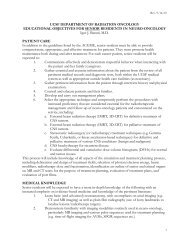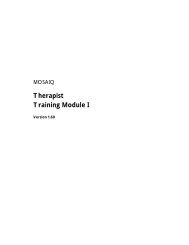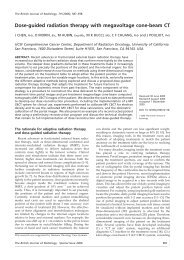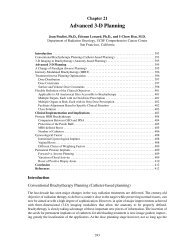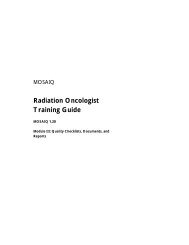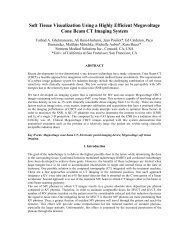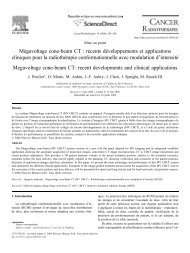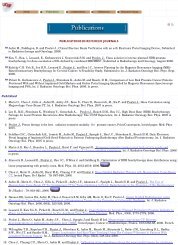Adobe Illustrator & Indesign Tutorial - UCSF Radiation Oncology ...
Adobe Illustrator & Indesign Tutorial - UCSF Radiation Oncology ...
Adobe Illustrator & Indesign Tutorial - UCSF Radiation Oncology ...
You also want an ePaper? Increase the reach of your titles
YUMPU automatically turns print PDFs into web optimized ePapers that Google loves.
<strong>Adobe</strong> <strong>Illustrator</strong> &<br />
<strong>Indesign</strong> <strong>Tutorial</strong><br />
presented by Robin Cheung<br />
Disclaimer: I’m not an employee of <strong>Adobe</strong> and have not been trained to<br />
provide instruction in these programs
<strong>Adobe</strong> Program Functions<br />
Photoshop photo editing, raster image creation<br />
<strong>Illustrator</strong> vector image creation<br />
InDesign layout
<strong>Adobe</strong> Program Functions<br />
Photoshop photo editing, raster image creation<br />
<strong>Illustrator</strong> vector image creation<br />
InDesign layout
Design Principles<br />
The goal of a scientific poster is to communicate informaton.
Hierarchy<br />
What is the most important thing on the page?<br />
What order do you want your reader to read in?<br />
If your reader spent 1 minute looking at your poster, what<br />
should they get from it? 5 mins? 10 mins?
Design Tools: Proximity<br />
It’s important to group information that is logically<br />
connected. This helps you organize information to<br />
create hierarchy.
Design Tools: Proximity<br />
Example images are from The Non-Designer’s Design Book by Robin Williams
Design Tools: Proximity<br />
Example images are from The Non-Designer’s Design Book by Robin Williams
Design Tools: Proximity
Design Tools: Proximity
Design Tools: Alignment<br />
Nothing should be placed arbitrarily on the page,<br />
everything should be visually connected.
Design Tools: Alignment
Design Tools: Alignment
Design Tools: Alignment
Design Tools: Alignment<br />
Create strong alignments to direct the eye
Design Tools: Repetition<br />
Create a visual system and stick to it.<br />
What do your headlines look like? What size font do<br />
you use for your paragraph text?
Design Tools: Repetition
Design Tools: Repetition
Design Tools: Contrast<br />
Contrast creates visual interest and helps distinguish<br />
different types of information.<br />
If the information you are communicating is similar,<br />
it should look similar. If the information you are<br />
communicating is different, it should look really<br />
different.
Design Tools: Contrast
Design Tools: Contrast
Design Tools: White Space<br />
White space is the empty areas in your layout.<br />
White space gives the eye a break and helps<br />
separate items from each other.<br />
Using white space well makes your information less<br />
overwhelming and confusing.
Design Tools: White Space<br />
Leading = the space between lines of text<br />
Sed magna faci tion henibh eu feumsan venisi.<br />
Ut non utat amet do dolorero consed dolent<br />
eum dipissenim do od diam nullaor iuscidunt<br />
venim aut vel incipsum vent acip eu feum ad<br />
elestrud te et nit augiamet ulputpat. Lesenissequi<br />
eum quat praesendiam, sum quip ea<br />
feuisl digna aliquat.<br />
Volupta tismodipis nim do odiam vulla feugiam<br />
vendigna cortie dunt adip ea commolo<br />
rperaessi blaorperci ex et nim vercidunt alissequis<br />
nonsectem doloborper susci tio od er<br />
at, quis adiat diam aliquipit, vullut luptat. Ut<br />
praesed magnit, conulput augait ullam nullamcon<br />
veliquam iliquam volortinis dolutatio<br />
Sed magna faci tion henibh eu feumsan venisi.<br />
Ut non utat amet do dolorero consed dolent<br />
eum dipissenim do od diam nullaor iuscidunt<br />
venim aut vel incipsum vent acip eu feum ad<br />
elestrud te et nit augiamet ulputpat. Lesenissequi<br />
eum quat praesendiam, sum quip ea<br />
feuisl digna aliquat.<br />
Volupta tismodipis nim do odiam vulla feugiam<br />
vendigna cortie dunt adip ea commolo<br />
rperaessi blaorperci ex et nim vercidunt alissequis<br />
nonsectem doloborper susci tio od er<br />
at, quis adiat diam aliquipit, vullut luptat. Ut<br />
praesed magnit, conulput augait ullam nullamcon<br />
veliquam iliquam volortinis dolutatio<br />
Sed magna faci tion henibh eu feumsan venisi.<br />
Ut non utat amet do dolorero consed dolent<br />
eum dipissenim do od diam nullaor iuscidunt<br />
venim aut vel incipsum vent acip eu feum ad<br />
elestrud te et nit augiamet ulputpat. Lesenis-<br />
sequi eum quat praesendiam, sum quip ea<br />
feuisl digna aliquat.<br />
Volupta tismodipis nim do odiam vulla feu-<br />
giam vendigna cortie dunt adip ea commolo<br />
rperaessi blaorperci ex et nim vercidunt alis-<br />
sequis nonsectem doloborper susci tio od er<br />
at, quis adiat diam aliquipit, vullut luptat. Ut<br />
praesed magnit, conulput augait ullam nul-<br />
lamcon veliquam iliquam volortinis dolutatio
Font Issues<br />
Do not use too many fonts. For most projects, one<br />
font is enough.
Font Issues<br />
For easy communication use appropriate, easy-to-read fonts<br />
not childish ones<br />
not hard to read ones<br />
not scripty ones<br />
not girly ones<br />
not weird ones
Dose Delivered to Patients for Megavoltage Cone-Beam CT Imaging<br />
Olivier Morin1,2, Je Bellerose1, Clayton Akazawa1, Amy Gillis1, Martina Descovich1, Michèle Aubin1, Josephine Chen1, Hong Chen1,<br />
Jean-François Aubry1, Ping Xia1,2 and Jean Pouliot1,2<br />
PURPOSE<br />
<strong>UCSF</strong><br />
University of California San Francisco<br />
1600 Divisadero Street, Suite H1031<br />
San Francisco CA 94143-1708<br />
Email: morin@radonc17.ucsf.edu<br />
WebSite: http://www.ucsf.edu/jpouliot/<br />
AAPM 2006 SU-FF-I-13<br />
1- Department of <strong>Radiation</strong> <strong>Oncology</strong>, <strong>UCSF</strong> Comprehensive Cancer Center<br />
2- <strong>UCSF</strong> / UC Berkeley Joint Graduate Group in Bioengineering<br />
Megavoltage Cone-Beam CT (MVCBCT) uses a<br />
conventional treatment unit equipped with a at<br />
panel detector to obtain a 3D representation of the<br />
patient in treatment position. MVCBCT has been<br />
used for 2 years in our clinic for anatomy verication<br />
and to improve patient alignment<br />
prior to dose delivery. Depending<br />
on the soft-tissue information<br />
required for setup we are currently<br />
using a total exposure ranging<br />
between 2-10 monitor units (MU).<br />
CT MVCBCT (5MU)<br />
The objectives of this work are:<br />
To evaluate the dose delivered to patients for MVCBCT acquisition.<br />
To develop a simple plan modication receipe to compensate for<br />
the dose received by daily MVCBCT.<br />
METHODS & MATERIALS<br />
The MVCBCT dose calculated by our treatment planning system<br />
(Phillips, Pinnacle) was compared to measurements.<br />
Typical MVCBCT acquisition:<br />
6 MV beam, 27.4 x 27.4 cm2 eld size, 145 cm source-detector distance, Arc: 270o to 110o Experimental setup to<br />
measure MVCBCT dose<br />
IMRT QA Cylinder<br />
MOSFETS and an<br />
ion chamber<br />
Dose (cGy/MVCBCT MU)<br />
1.12<br />
1.05<br />
-2.1 % 1.7 %<br />
2.3 %<br />
0.95<br />
0.3 %<br />
-1.1 %<br />
1.4 % 0.2 %<br />
0.85<br />
2.8 % 1.4 %<br />
0.75<br />
-0.9 %<br />
2.6 %<br />
16 cm<br />
Percentage dierence<br />
between the dose<br />
calculated by Pinnacle<br />
and the measurements<br />
ALL WITHIN 3 %<br />
MVCBCT acquisition<br />
simulated in Pinnacle<br />
Simulation of an arc<br />
treatment with<br />
MVCBCT setting<br />
Pinnacle can be used to simulate the<br />
MVCBCT dose received by the patients.<br />
Normalized Volume<br />
RESULTS<br />
100<br />
90<br />
80<br />
70<br />
60<br />
50<br />
40<br />
30<br />
20<br />
10<br />
MVCBCT Portal Imaging<br />
or Film<br />
Tx (solid) with Tx+MVCBCT (dashed)<br />
Rectum<br />
Right Femoral<br />
Spinal Cord<br />
Penis Bulb<br />
cGy per MU<br />
1.2<br />
1.1<br />
1.0<br />
0.9<br />
0.8<br />
0.7<br />
0.6<br />
0.4<br />
Bladder<br />
0<br />
0 10 20 30 40 50 60 70 80<br />
CONCLUSION<br />
Seminal Vesicles<br />
Prostate<br />
90<br />
80<br />
70<br />
60<br />
50<br />
40<br />
30<br />
20<br />
10<br />
Dose (Gy)<br />
MVCBCT dose evaluated in the treatment planning system<br />
Table 1. Dose per fraction delivered to prostate<br />
patients at <strong>UCSF</strong> for daily alignment verication.<br />
MVCBCT (9 MU) and portal imaging (4 x 2 MU = 8 MU).<br />
Simple method to compensate for daily MVCBCT<br />
Prostate (daily 9MU MVCBCT, 40 fractions)<br />
Head and Neck (daily 5 MU MVCBCT, 33 fractions)<br />
Tx Alone Tx + MVCBCT Compensated Tx<br />
+ MVCBCT<br />
A compensation factor (CBCF) was introduced<br />
to keep the target mean dose the same.<br />
Tx Alone Tx + MVCBCT Compensated Tx<br />
+ MVCBCT<br />
77 Gy<br />
70 Gy<br />
55 Gy<br />
45 Gy<br />
35 Gy<br />
28 Gy<br />
15 Gy<br />
Prostate<br />
Seminal Ves.<br />
Nodes<br />
Rectum<br />
Bladder<br />
Penis Bulb<br />
Small Bowel<br />
Spinal Cord<br />
MVCBCT [cGy] Portal Imaging [cGy]<br />
Min Mean Max Min Mean Max<br />
6.4<br />
6.3<br />
5.2<br />
5.3<br />
6.7<br />
6.5<br />
2.7<br />
0.9<br />
6.9<br />
6.5<br />
6.8<br />
5.9<br />
7.8<br />
6.9<br />
8.3<br />
3.9<br />
Tx (solid) with CBCF. Tx+MVCBCT (dashed)<br />
100<br />
CBCF = 96%<br />
0<br />
0 10 20 30 40 50 60 70 80<br />
7.6<br />
6.8<br />
10.1<br />
6.8<br />
9.5<br />
7.6<br />
11.2<br />
5.2<br />
5.5<br />
5.4<br />
4.4<br />
4.8<br />
5.8<br />
5.8<br />
3.0<br />
0.8<br />
20<br />
Brain<br />
20<br />
10<br />
Right Eye<br />
10<br />
0<br />
0 10 20 30 40 50 60 70 80<br />
0<br />
0 10 20 30 40 50 60 70 80<br />
Dose (Gy)<br />
Patient CT scans can be imported in Pinnacle to evaluate the dose delivered by MVCBCT. For a typical MVCBCT, the delivered dose forms<br />
a small anterior-posterior gradient roughly ranging from 0.6 to 1.2 cGy per MVCBCT MU. A MVCBCT acquisition of 9 MU in the pelvis area<br />
delivers slightly more dose than what is currently delivered by portal imaging at <strong>UCSF</strong>. Daily 9 MU MVCBCT remains a small dose addition<br />
compared to treatment dose (
What’s good about it?<br />
Repetition good visual system<br />
Contrast
What needs work?<br />
White space poster is too crowded, overwhelming<br />
Alignment
Dose Delivered to Patients for Megavoltage Cone-Beam CT Imaging<br />
Olivier Morin1,2, Je Bellerose1, Clayton Akazawa1, Amy Gillis1, Martina Descovich1, Michèle Aubin1, Josephine Chen1, Hong Chen1,<br />
Jean-François Aubry1, Ping Xia1,2 and Jean Pouliot1,2<br />
PURPOSE<br />
<strong>UCSF</strong><br />
University of California San Francisco<br />
1600 Divisadero Street, Suite H1031<br />
San Francisco CA 94143-1708<br />
Email: morin@radonc17.ucsf.edu<br />
WebSite: http://www.ucsf.edu/jpouliot/<br />
AAPM 2006 SU-FF-I-13<br />
1- Department of <strong>Radiation</strong> <strong>Oncology</strong>, <strong>UCSF</strong> Comprehensive Cancer Center<br />
2- <strong>UCSF</strong> / UC Berkeley Joint Graduate Group in Bioengineering<br />
Megavoltage Cone-Beam CT (MVCBCT) uses a<br />
conventional treatment unit equipped with a at<br />
panel detector to obtain a 3D representation of the<br />
patient in treatment position. MVCBCT has been<br />
used for 2 years in our clinic for anatomy verication<br />
and to improve patient alignment<br />
prior to dose delivery. Depending<br />
on the soft-tissue information<br />
required for setup we are currently<br />
using a total exposure ranging<br />
between 2-10 monitor units (MU).<br />
CT MVCBCT (5MU)<br />
The objectives of this work are:<br />
To evaluate the dose delivered to patients for MVCBCT acquisition.<br />
To develop a simple plan modication receipe to compensate for<br />
the dose received by daily MVCBCT.<br />
METHODS & MATERIALS<br />
The MVCBCT dose calculated by our treatment planning system<br />
(Phillips, Pinnacle) was compared to measurements.<br />
Typical MVCBCT acquisition:<br />
6 MV beam, 27.4 x 27.4 cm2 eld size, 145 cm source-detector distance, Arc: 270o to 110o Experimental setup to<br />
measure MVCBCT dose<br />
IMRT QA Cylinder<br />
MOSFETS and an<br />
ion chamber<br />
Dose (cGy/MVCBCT MU)<br />
1.12<br />
1.05<br />
-2.1 % 1.7 %<br />
2.3 %<br />
0.95<br />
0.3 %<br />
-1.1 %<br />
1.4 % 0.2 %<br />
0.85<br />
2.8 % 1.4 %<br />
0.75<br />
-0.9 %<br />
2.6 %<br />
16 cm<br />
Percentage dierence<br />
between the dose<br />
calculated by Pinnacle<br />
and the measurements<br />
ALL WITHIN 3 %<br />
MVCBCT acquisition<br />
simulated in Pinnacle<br />
Simulation of an arc<br />
treatment with<br />
MVCBCT setting<br />
Pinnacle can be used to simulate the<br />
MVCBCT dose received by the patients.<br />
Normalized Volume<br />
RESULTS<br />
100<br />
90<br />
80<br />
70<br />
60<br />
50<br />
40<br />
30<br />
20<br />
10<br />
MVCBCT Portal Imaging<br />
or Film<br />
Tx (solid) with Tx+MVCBCT (dashed)<br />
Rectum<br />
Right Femoral<br />
Spinal Cord<br />
Penis Bulb<br />
cGy per MU<br />
1.2<br />
1.1<br />
1.0<br />
0.9<br />
0.8<br />
0.7<br />
0.6<br />
0.4<br />
Bladder<br />
0<br />
0 10 20 30 40 50 60 70 80<br />
CONCLUSION<br />
Seminal Vesicles<br />
Prostate<br />
90<br />
80<br />
70<br />
60<br />
50<br />
40<br />
30<br />
20<br />
10<br />
Dose (Gy)<br />
MVCBCT dose evaluated in the treatment planning system<br />
Table 1. Dose per fraction delivered to prostate<br />
patients at <strong>UCSF</strong> for daily alignment verication.<br />
MVCBCT (9 MU) and portal imaging (4 x 2 MU = 8 MU).<br />
Simple method to compensate for daily MVCBCT<br />
Prostate (daily 9MU MVCBCT, 40 fractions)<br />
Head and Neck (daily 5 MU MVCBCT, 33 fractions)<br />
Tx Alone Tx + MVCBCT Compensated Tx<br />
+ MVCBCT<br />
A compensation factor (CBCF) was introduced<br />
to keep the target mean dose the same.<br />
Tx Alone Tx + MVCBCT Compensated Tx<br />
+ MVCBCT<br />
77 Gy<br />
70 Gy<br />
55 Gy<br />
45 Gy<br />
35 Gy<br />
28 Gy<br />
15 Gy<br />
Prostate<br />
Seminal Ves.<br />
Nodes<br />
Rectum<br />
Bladder<br />
Penis Bulb<br />
Small Bowel<br />
Spinal Cord<br />
MVCBCT [cGy] Portal Imaging [cGy]<br />
Min Mean Max Min Mean Max<br />
6.4<br />
6.3<br />
5.2<br />
5.3<br />
6.7<br />
6.5<br />
2.7<br />
0.9<br />
6.9<br />
6.5<br />
6.8<br />
5.9<br />
7.8<br />
6.9<br />
8.3<br />
3.9<br />
Tx (solid) with CBCF. Tx+MVCBCT (dashed)<br />
100<br />
CBCF = 96%<br />
0<br />
0 10 20 30 40 50 60 70 80<br />
7.6<br />
6.8<br />
10.1<br />
6.8<br />
9.5<br />
7.6<br />
11.2<br />
5.2<br />
5.5<br />
5.4<br />
4.4<br />
4.8<br />
5.8<br />
5.8<br />
3.0<br />
0.8<br />
20<br />
Brain<br />
20<br />
10<br />
Right Eye<br />
10<br />
0<br />
0 10 20 30 40 50 60 70 80<br />
0<br />
0 10 20 30 40 50 60 70 80<br />
Dose (Gy)<br />
Patient CT scans can be imported in Pinnacle to evaluate the dose delivered by MVCBCT. For a typical MVCBCT, the delivered dose forms<br />
a small anterior-posterior gradient roughly ranging from 0.6 to 1.2 cGy per MVCBCT MU. A MVCBCT acquisition of 9 MU in the pelvis area<br />
delivers slightly more dose than what is currently delivered by portal imaging at <strong>UCSF</strong>. Daily 9 MU MVCBCT remains a small dose addition<br />
compared to treatment dose (
DOSE DELIVERED TO PATIENTS FOR MEGAVOLTAGE CONE-BEAM CT IMAGING<br />
Olivier Morin 1,2 , Jeff Bellerose 1 , Clayton Akazawa 1 , Amy Gillis 1 , Martina Descovich 1 , Michèle Aubin 1 , Josephine Chen 1 ,<br />
Hong Chen 1 , Jean-François Aubry 1 , Ping Xia 1,2 and Jean Pouliot 1,2<br />
1 Department of <strong>Radiation</strong> <strong>Oncology</strong>, <strong>UCSF</strong> Comprehensive Cancer Center<br />
2 <strong>UCSF</strong> / UC Berkeley Joint Graduate Group in Bioengineering<br />
PURPOSE<br />
Megavoltage Cone-Beam CT (MVCBCT) uses a<br />
conventional treatment unit equipped with a flat<br />
panel detector to obtain a 3D representation of<br />
the patient in treatment position. MVCBCT has<br />
been used for 2 years in our clinic for anatomy<br />
verification and to improve patient alignment prior<br />
to dose delivery. Depending on the soft-tissue<br />
information required for setup we are currently<br />
using a total exposure ranging between 2-10<br />
monitor units (MU).<br />
The objectives of this work are:<br />
♦ To evaluate the dose delivered to<br />
patients for MVCBCT acquisition.<br />
♦ To develop a simple plan modifi-cation<br />
receipe to compensate for the dose<br />
received by daily MVCBCT.<br />
METHODS & MATERIALS<br />
CT MVCBCT (5MU)<br />
♦ The MVCBCT dose calculated by our treatment planning system<br />
(Phillips, Pinnacle) was compared to measurements.<br />
Typical MVCBCT acquisition: 6 MV beam, 27.4 x 27.4 cm 2 field size,<br />
145 cm source-detector distance, Arc: 270 o to 110 o<br />
Experimental setup to<br />
measure MVCBCT dose<br />
IMRT QA Cylinder MOSFETS<br />
and an ion chamber<br />
Percentage difference between<br />
the dose calculated by Pinnacle<br />
and the measurements<br />
ALL WITHIN 3 %*<br />
MVCBCT acquisition<br />
simulated in Pinnacle<br />
Simulation of an arc treatment<br />
with MVCBCT setting<br />
Pinnacle can be used to simulate the MVCBCT dose received by the patients.<br />
RESULTS<br />
MVCBCT dose evaluated in the treatment planning system<br />
CONCLUSION<br />
GTV<br />
CTV<br />
M andible<br />
Spinal Cord<br />
Left Parotid<br />
Brain tem s<br />
Skin<br />
Right lens<br />
GTV<br />
CTV<br />
M andible<br />
Spinal Cord<br />
Left Parotid<br />
Brain tem s<br />
Skin<br />
Right lens<br />
MVCBCT [c Gy] CR Film Gy] [c<br />
Min Mean Max Min M ean Max<br />
4.7<br />
2.7<br />
3.5<br />
3.3<br />
2.4<br />
6.5<br />
2.7<br />
0.9<br />
5.2<br />
5.0<br />
5.4<br />
4.2<br />
4.9<br />
6.9<br />
8.3<br />
3.9<br />
5.8<br />
5.8<br />
6.0<br />
4.8<br />
5.3<br />
7.6<br />
11.2<br />
5.2<br />
6.6<br />
3.8<br />
5.5<br />
5.1<br />
4.2<br />
6.6<br />
0.0<br />
5.4<br />
Simple method to compensate for daily MVCBCT<br />
Patient CT scans can be imported in Pinnacle to evaluate the dose delivered by MVCBCT. For a typical MVCBCT, the delivered dose<br />
forms a small anterior-posterior gradient roughly ranging from 0.6 to 1.2 cGy per MVCBCT MU. A MVCBCT acquisition of 9 MU<br />
in the pelvis area delivers slightly more dose than what is currently delivered by portal imaging at <strong>UCSF</strong>. Daily 9 MU MVCBCT<br />
remains a small dose addition compared to treatment dose (
Design Tools Summary<br />
Proximity<br />
Alignment<br />
Repetition<br />
Contrast<br />
White space



